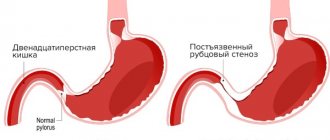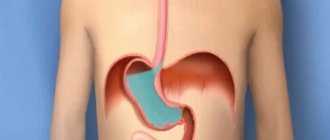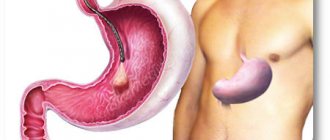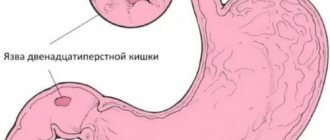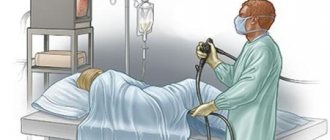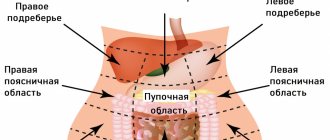Why exactly half of the intestine is removed?
Why, even with a small malignant tumor located far from the midline of the colon, is it customary to remove the entire half of the intestine? Why is it not enough to resect only the area with the tumor?
This is due to several reasons:
Features of blood supply. The right and left halves of the large intestine are supplied with blood by different branches: the right half - from the superior mesenteric artery, the left half - from the inferior mesenteric artery. When one of the branches is ligated, the entire half of the intestine is cut off from the blood supply.- The intestinal anastomosis will be most reliable when formed in an area with a mobile part of the colon, covered on all sides by the peritoneum. This area is the transverse colon. And the ascending and descending sections of the large intestine are not completely covered by the peritoneum.
- In case of cancer, maximum removal of regional lymph nodes en bloc with the tumor is necessary. Lymph nodes are located in the mesentery along the blood vessels, as well as in the retroperitoneal tissue.
Diet after right hemicolectomy
The consequences of radical operations on the colon
sharply reduce the quality of life of patients. And if the short small bowel syndrome has been and is being given quite a lot of attention, the consequences of hemicolectomies, proctocolectomies with reconstruction have again begun to attract the attention of specialists in recent years. However, the radicalism of colectomy poses a difficult task for the surgeon, and in the long term for the therapist, gastroenterologist, and nutritionist, to ensure functional adaptation of the intestine. The solution to this problem is based on the physiological and pathophysiological characteristics of various parts of the large intestine.
It is known that the colon
performs mainly storage and reservoir functions; digestion is practically absent in it. This is a fecal-forming organ, involved not only in the formation, but also in the evacuation of feces, as well as in the processes of absorption of water, electrolytes, some vitamins, and even to a certain extent glucose and amino acids. It is also known that from the total amount of drunk and secreted fluid (1.5 l of saliva, 2.5 l of gastric juice, 0.5 l of bile, 1.5 l of pancreatic secretion, 1.0 l of intestinal “juice”) into the colon an average of 1.5-2.0 liters enters, but only 100.0-150.0 ml is excreted in the feces, the rest of the volume is absorbed in it.
In this case, the cecum and ascending colon
They also absorb liquid, electrolytes, vitamins, and also utilize protein fragments and fiber that accidentally enter the small intestine.
The transverse colon
primarily transports intestinal contents and is only partially involved in the regulation of water and electrolyte metabolism.
However, most surgeons
Based on an analysis of the quality of life of patients with the preservation and removal of the ileocecal angle, they still adhere to the position that this section is functionally significant as a regulator of motor activity and as a barrier against the translocation of intestinal microflora in the proximal direction, and that it takes part in the absorption and metabolism, primarily of vitamin B12.
The left half of the colon
, especially the sigmoid colon, performs a reservoir (storage) function.
For a long time it was believed that these were all the main functions of the colon.
. However, when analyzing the consequences of extensive resections of the colon and colectomies, the level of resections reveals very specific changes both in the stump of the colon and in other organs and systems functionally interconnected with the colon (P.K. Klimov). The quality of life of most patients who have undergone extensive resections of various parts of the colon suffers significantly not only from disorders associated with fecal formation and dyselectrolythemia, but also from pathological changes in interstitial metabolism that gradually develop in the corresponding organs.
Therefore, when refining the metabolic program
(including nutritional) correction, special attention should be paid to limiting organs (the liver with its unique detoxification function, the kidneys, the capabilities of the upper parts of the digestive canal to ensure sufficient digestibility and assimilation of transintestinal diets, etc.).
The defining moments
in the pathogenesis of emerging metabolic disorders are undoubtedly the loss of functions of segments of the colon or its entire surface as a whole.
It should be noted that one of the pathogenetically significant components of the development of consequences after hemicolectomies
is the translocation of microorganisms, which are present in the most significant quantities and diversity in the large intestine.
In addition, microbial flora in the colon
ensures the digestion of dietary fiber, fiber, which is not absorbed in the overlying sections. This process is directly involved in additional energy supply due to products synthesized by the colonic microflora (short-chain fatty acids - SCFA) during its vital activity (its absorption of fiber).
It also takes part in the absorption of water, sodium, chlorine, calcium, and magnesium.
Adequate detoxification function of the colon
is also to a certain extent related to the capabilities of the microbiota. Another mechanism of detoxification associated with the microflora of the colon is associated with the conversion of bilirubin into urobilinogen, which is partially absorbed and excreted in the urine, and partially also excreted in the feces.
Local SCLC
also take part in the regulation of intestinal motility, as can be seen in the electromyograms of the gastrointestinal tract performed at the Central Research Institute of Geology, which make it possible not only to assess the state of the motor function of various parts of the intestine, but also to compare, in particular, the motility of the colon with the contractile activity of the gallbladder in patients with right - and left-sided hemicolectomies.
In patients with consequences of left-sided hemicolectomy
As a rule, there is a pronounced decrease in body weight, pain along the colon and constipation. This is comparable to the characteristics of the electromyographic curves of the common bile duct and colon stump.
In patients with left hemicolectomy
As a rule, hypomotor dyskinesia of the colon is observed (amplitude 0.11±0.02 mV, frequency 4.0±0.6 per minute).
After treatment with the use of a corrective nutritional mixture for enteral administration, the electrical and motor activity of the colon tends to recover (the amplitude of the electrical wave increases to approximately 0.2 + 0.02 mV, frequency - to 6.3 + 0.6 reflections per minute. ). Patients with right-sided hemicolectomy
more often experience pain in the paraumbilical area, a very significant decrease in body weight, and diarrhea.
In patients with right hemicolectomy
(performed for complicated Crohn's disease), the motor activity of the smooth muscles of the biliary tract is increased, as is the motor activity of the muscles of the colon.
Electromyographically
: hypermotor dyskinesia of the colon with a rhythm frequency of 14.5 ± 1.5 per minute (58.6%) and an amplitude of the electromyographic curve of 0.17 ± 0.02 mV.
Treatment with pre- and probiotics
in combination with mucofalk led to a decrease in the frequency of slow waves of electromyographic activity (EMA) to 6.0 ± 0.7 per minute; the amplitude was 0.22 ± 0.04 mV.
Thus, electromyographic changes
can be used to clarify the characteristics of intestinal motility after extensive operations on the colon and indications for the choice of tactics for enteral correction of its motor activity and general protein-energy deficiency.
Therefore, the role of the colonic microbiota
also affects lipid metabolism, which during colectomies and extensive colonic resections manifests itself as lipid distress syndrome.
In other words, in case of disturbances in the activity of the colon microbiota
you can expect: - impaired absorption of cholesterol from the intestines; — disturbances in the transit of cholesterol through the gastrointestinal tract; — disturbances in the transformation of cholesterol into neutral sterols and end products; - disturbances in the transformation of cholesterol into bile acids and steroid hormones; - increasing cholesterol synthesis by microorganisms; — increasing the synthesis of cholesterol by human organ cells.
When choosing tactics for siping and parenteral-enteral correction
In patients with extensive colon resections, it is important to pay attention to possible vitamin deficiency, because Another important metabolic function of intestinal microflora is the synthesis of vitamins (especially groups B and K).
Vitamin K
, as is known, is necessary for the body for calcium-binding proteins that ensure the functioning of the blood coagulation system, neuromuscular transmission, bone structure, etc. It is represented by a complex of chemical compounds, such as vitamin K1 - phyloquinone (plant origin), vitamin K2 - a group of menaquinones - synthesized more small intestinal microflora, etc. However, even in the absence of significant areas of the large intestine, a number of authors have noted manifestations of deficiency of these vitamins.
The fact is that for the normal functioning of
the colon bacteria
Choosing the composition for alimentation of the contingent
, it is advisable to pay attention to the state of the microbiota in the colonic stump, correcting its activity, for example, with prebiotics (including ready-made industrial compositions for nutritional support).
Thus, determining the tactics of nutritional support
in case of consequences of postcolectomy syndrome or consequences of extensive resections of the colon, it is first necessary to clarify the level and volume of resection, the characteristics of the clinical manifestations of its consequences, the degree of functional safety and the severity of adaptive reactions.
Removal of the entire colon
, as a rule, is clinically manifested by signs of uncompensated disturbances in water-electrolyte, protein-energy balances, loss of functions of regulatory hormones, the source of which is, among other things, the colon: enteroglucagon, peptide YY, neurotensin, partially motilin (Mo-cells).
Preliminary preparation for surgery
Hemicolectomy for intestinal cancer is a radical operation performed for life-saving reasons. It is not performed in patients with multiple distant metastases. Absolute contraindications also include:
- General serious condition.
- Decompensation of heart failure.
- Severe form of diabetes mellitus with multiple complications.
- Kidney and liver failure.
- Acute infectious disease.
In preparation for surgery, a certain amount of examination is prescribed:
- General and biochemical blood tests.
- Analysis of urine.
- Study of the coagulation system.
- Electrolyte balance study.
- Markers of infectious diseases (HIV, hepatitis, syphilis).
- X-ray of the chest organs.
- Ultrasound or CT scan of the abdominal cavity.
- Examination by a therapist and specialists in the presence of a chronic disease.
Anemia, exhaustion, and impaired water-salt metabolism often accompany oncopathology. However, these conditions are not a contraindication to hemicolectomy. They can be adjusted during preoperative preparation. This will delay the operation somewhat, but will allow you to approach it with minimal risk of postoperative complications.
Such patients can be given a blood or red blood cell transfusion for anemia, a transfusion of saline solutions for electrolyte imbalance, plasma and amino acid solutions for exhaustion and hypoalbuminemia. Metabolic drugs that improve metabolic processes in tissues are also prescribed.
If there are signs of cardiac dysfunction, treatment is carried out to improve hemodynamics (cardiac glycosides are prescribed for heart failure, antiarrhythmic drugs to correct arrhythmia, antihypertensive drugs to normalize blood pressure).
Patients with diabetes are examined by an endocrinologist, and insulin therapy regimens are selected that are most convenient for correcting sugar levels in the postoperative period.
The maximum possible compensation of respiratory failure in patients with COPD is also necessary. Smoking cessation is strongly recommended.
Men with prostate adenoma are examined by a urologist.
If you have varicose veins or a history of thrombophlebitis, elastic bandaging of the limbs before surgery is necessary.
The nutrition of patients before hemicolectomy should be complete and consist of foods containing easily digestible proteins and vitamins (boiled meat, pureed soups, cottage cheese, eggs, fruit and vegetable purees, juices). High fiber foods (raw vegetables and fruits, legumes, brown bread, nuts) are not allowed.
Psychological preparation is also necessary; the essence of the operation, possible complications, and rules of behavior in the postoperative period are explained to the patient. The patient should also practice fulfilling his physiological needs in a supine position.
On the eve of the operation
A very important point when preparing any operations on the intestines is to cleanse it of contents on the eve of the operation, as well as to suppress pathogenic microbes.
Different clinics use different schemes for preoperative bowel preparation. Usually, two days before the scheduled operation, a saline laxative (magnesium sulfate solution) is prescribed several times a day, only liquid food, and a cleansing enema in the evening.
On the day before the operation, only a light breakfast, saline laxative 2 times or intestinal lavage are allowed. Lavage is a more modern method of colon cleansing, quite effective and convenient. Its essence is to take 3-4 liters of a special balanced osmotic solution on the eve of the operation. The basis for the solution is drugs such as Macrogol, Fortrans, Colite, Golitel. They are available in bags intended for dilution with water.
In addition, on the eve of the operation, the patient is given a non-absorbable antibiotic once or several times a day to suppress intestinal microflora - neomycin, kanamycin, erythromycin.
Some clinics practice intravenous antibiotic administration 1 hour before surgery (cefoxitin or metronidazole).
On the day of surgery you should not eat or drink.
How to prepare for upcoming surgery
Fortrans
To avoid the development of inflammatory processes that may appear during hemicolectomy, as well as in the early postoperative period, it is recommended to completely clear the intestinal cavity of the contents. What drug is effective for cleaning the intestines before surgery? It is possible to recommend the use of the drug “Fortrans”, which is used one day before the start of surgery.
This remedy completely helps to evacuate intestinal contents and significantly reduce the risk of infection of patients during the intervention. It is also recommended to take Fortrans before a colonoscopy (examination of the large intestine using a special probe).
Progress of the operation
The hemicolectomy operation is performed under general anesthesia. Usually this is intubation anesthesia with the use of muscle relaxants.
1. Cut. A midline or lateral right or left pararectal incision is made. The incision should provide maximum access to the surgical field and, if possible, not disrupt the function of the abdominal press.
2. Revision of the abdominal cavity. Operability, the presence of other pathology in the abdominal cavity, the presence of metastases, and the extent of resection are determined.
3. Mobilization of the intestines.
With a right hemicolectomy, part of the ileum (10-15 cm long), the cecum, the ascending colon and the transverse colon (its right half) are mobilized. To mobilize the intestine means to turn it off from the blood supply by ligating the vessels and give it mobility by crossing the mesentery and bluntly separating it from the retroperitoneal tissue in places not covered by the peritoneum.
in the picture on the left: right-sided hemicolectomy, in the picture on the right: left-sided hemicolectomy
With left hemicolectomy, a similar operation is performed with the transverse colon, descending colon and sigmoid colon. The right enterophrenic ligament is also transected to smoothly bring down the right half of the colon and create an anastomosis.
4. Direct resection. Two clamps are applied to the transverse colon, between which the colon is divided. The resected part of the colon is brought into the wound and removed en bloc with the mesentery, part of the greater omentum, retroperitoneal tissue and regional lymph nodes. The crossed ends of the intestine are treated with an antiseptic.
5. Creation of anastomosis. With a right hemicolectomy, an anastomosis is performed between the ileum and the transverse colon in a side-to-side or end-to-side fashion. When the left half of the intestine is removed, an end-to-end anastomosis is performed between the transverse colon and the sigmoid colon. The intestinal walls are sutured with a two-row or three-row suture or with a special stitching machine.
6. A drainage is installed at the site of the anastomosis. The wound is sutured.
It is not always possible to perform the operation simultaneously. In severe and debilitated patients, especially when performing a left-sided hemicolectomy, an unloading cecostoma (artificial sigmoid fistula) or colostomy is often applied. This is necessary to divert intestinal contents outside to reduce the load on the anastomosis. After the anastomosis has healed, the colostomy is sutured.
For cancer complicated by intestinal obstruction, a three-stage operation is performed: 1st stage - application of a discharge colostomy, 2nd stage - hemicolectomy after preparation, 3rd stage - suturing the colostomy.
Hemicolectomy - surgery to remove part of the colon
A hemicolectomy is an operation in which half of the colon is removed. The method is most often used to remove inoperable cancerous tumors, but hemicolectomy has other indications. Both the right and left parts of the organ can be excised.
Indications
The operation is radical and is prescribed if pathological processes pose a threat to the patient’s life. Direct indications include:
- malignant intestinal tumors;
- volvulus of the colon;
- organ obstruction;
- ischemic or ulcerative colitis;
- perforation of the walls of the large intestine;
- irreversible circulatory disorders;
- polyposis;
- complicated Crohn's disease.
Contraindications
The operation is not advisable if:
- general unsatisfactory condition of the patient;
- heart, kidney and liver failure;
- diabetes mellitus;
- acute infectious diseases and processes;
- proliferation of metastases into neighboring organs and tissues.
ATTENTION! Urgent hemicolectomy, prescribed for health reasons, has no absolute contraindications.
Preparation
During the preparatory stage, the patient must pass:
- general analysis of urine and blood;
- blood chemistry;
- coagulogram;
- tests for HIV, syphilis and hepatitis;
- X-ray of the thoracic organs;
- Ultrasound or CT scan of the abdominal cavity.
It is mandatory to undergo an examination by a therapist and specialized specialists if you have other chronic diseases.
Patients with malignant tumors undergo therapy, during which the state of anemia, impaired water-salt balance and general exhaustion of the body are corrected.
Doctors achieve positive dynamics through blood transfusions, the introduction of saline solutions, plasma and amino acid compounds and the prescription of metabolic agents.
This takes extra time, but minimizes the risk of complications.
Patients with impaired vein patency and varicose veins have their legs tightly bandaged before surgery.
For some time before hemicolectomy, the patient follows a special diet. Easily digestible protein products are introduced into the diet. Eating foods high in fiber is prohibited.
Preparation before the procedure
It is very important to properly cleanse the intestines before surgery. Two days before surgery, the patient switches to liquid food and takes a saline laxative. In the evening, the patient is given a cleansing enema.
The last meal before the procedure is breakfast. After this, a double dose of laxative and an enema are indicated.
To suppress the activity of pathogenic bacteria present in the intestinal microflora, the patient takes non-absorbable antibiotics on the eve of surgery.
ATTENTION! On the day of the operation, not only food, but also drinking is prohibited.
Open access technique
Hemicolectomy is performed open and laparoscopically, i.e. instruments are inserted into the working area through small punctures in the skin.
With open access, an incision is formed on the anterior part of the abdominal wall - median or right/left-sided. The incision should not disrupt the function of the abdominal muscles, but it should provide free access to the organ.
After examining the intestines for the volume and location of pathology, the doctor begins to mobilize the large intestine. The vessels communicating with the excised part of the organ are ligated or cauterized. The mesentery and the tissue adjacent to the walls of the organ are separated using a blunt method.
Clamps are applied to the transverse colon segment of the intestine. The part of the intestine to be removed is removed through a peritoneal incision and excised along with the mesentery, a fragment of the omentum, lymph nodes and tissue. The amputation ends are disinfected using an antiseptic composition.
The next stage is the formation of an anastomosis. In a right-sided operation, it is placed between the ileum and transverse colon and according to the “side to side” or “end to side” principle. In left-sided surgery, the anastomosis connects the transverse colon and sigmoid colon according to the “end to end” principle. The walls of the organ are sutured with a suture in two or three rows.
The final stage is installation of a drainage system and layer-by-layer suturing of the abdominal cavity.
ATTENTION! In some cases, the operation simply cannot be performed at once, so the surgeon creates a temporary colostomy, which is sutured during repeated intervention.
Technique for laparoscopic access
All necessary equipment is inserted into the abdominal cavity through punctures, the total number of which can reach 5. The stages of the operation are similar to the classical technique. The amputated part of the organ is removed through an incision no larger than three centimeters.
Postoperative period
After the operation, the patient remains in the intensive care unit for several days under constant observation. Nutrition during this period is only parenteral. A probe is placed through the nose into the intestine above the anastomosis, through which the intestinal contents are suctioned.
On the 2nd day the patient is allowed to get up and walk to prevent adhesions. Drinking is allowed at this time.
From the 3rd day, liquid food without toxins is allowed - vegetable decoctions, broths, pureed soups, liquid semolina porridge. The patient remains on this diet for 6-7 days. Duphalac, castor oil capsules, and petroleum jelly are used to liquefy stool.
The diet is gradually expanding. If the course is favorable, the patient is discharged on days 14-16. However, dietary restrictions remain for a long time. The period of early adaptation and pronounced functional disorders of the intestine after surgery lasts up to 2 months, the period of complete adaptation lasts up to 4-6 months, sometimes up to a year.
Laparoscopic hemicolectomy
Laparoscopic hemicolectomy is an analogue of open surgery, but performed using modern endoscopic equipment, without large incisions in the abdominal wall.
The advantage of laparoscopic surgery is that it occurs with less tissue trauma and the recovery period is faster. This method is more preferable in weakened patients.
After 4-5 punctures, a laparoscope and trocars with instruments are introduced into the abdominal cavity. The main stages of the operation do not differ from those with the open method. With the laparoscopic method, suturing is more common using special stitching devices, which are also inserted through punctures in the abdominal wall.
During left-sided hemicolectomy, to create an end-to-end anastomosis, one part of the device is inserted into the lumen of the colon stump, and the second part is inserted through the anus into the sigmoid stump. A circular suture is created, after which the device is removed peranally.
The section of intestine to be removed is removed from the abdominal cavity through a 3-4 cm incision.
Sometimes a purely laparoscopic operation cannot be performed. In case of large tumors or the impossibility for some reason of performing an anastomosis inside the abdominal cavity, surgeons widen the laparoscopic incision, the intestine is brought out into the wound and anastomosis is performed in an open manner. This method of intervention is considered combined.
Complications
The main complication after G.'s operation is diffuse or limited peritonitis (see). There are two main groups of postoperative peritonitis: peritonitis that develops with complete sealing of the sutures of the interintestinal anastomosis, associated with infection of the abdominal cavity at the time of surgery, and peritonitis caused by the failure of the sutures of the interintestinal anastomosis. When antibiotics are used during preoperative preparation, during surgery and in the postoperative period, peritonitis of the first group is relatively rare. Their prevention consists of gentle operation with careful observance of all asepsis rules (see).
Postoperative peritonitis caused by insufficient sutures of the intestinal anastomosis is more common. Its clinical manifestations, as a rule, are detected on the 4th—6th day after surgery. Prevention of postoperative peritonitis in this group consists of special preparation of patients, unloading cecostomy, or refusal of a one-stage operation with intra-abdominal anastomosis after intestinal resection. If signs of peritonitis appear in the postoperative period, urgent relaparotomy is indicated, and the sooner it is done, the greater the chance of success of subsequent treatment. In most such cases, the incompetent anastomosis is removed outside the abdominal cavity in the form of a fecal fistula, and if it is impossible to remove it due to infiltration and poor mobility of this section of the intestine, the anastomosis zone is switched off by crossing the adductor segment of the intestine above the anastomosis with the imposition of a complete (temporary) fecal fistula on it and subsequent delimiting tamponade of the area of the incompetent anastomosis.
Postoperative mortality in G. varies widely. This is explained by the fact that G. is used for various disease processes, and the results of the operation are directly dependent not only on the nature of the disease process, but also on the degree of its manifestation and stage of development. Thus, during operations for acute intestinal obstruction (volvulus or nodulation) in the early stages, postoperative mortality does not exceed 2-5%, and with intestinal necrosis it increases many times. In case of colon cancer, during planned operations performed after proper preparation, postoperative mortality ranges from 1.5 to 4%, and during emergency operations for obstructive intestinal obstruction caused by a tumor, especially with tumor perforation, it reaches 50-60%. .
Bibliography:
Littmann I. Abdominal surgery, trans. with German, p. 309, Budapest, 1970; P yzh and A. N. Atlas of operations on the rectum and colon, p. 282, 294, M., 1968; G o 1 igher JG Surgery of the anus, rectum and colon, L., 1975.

